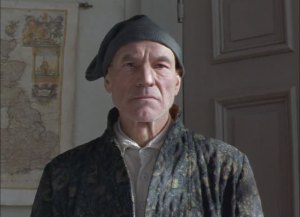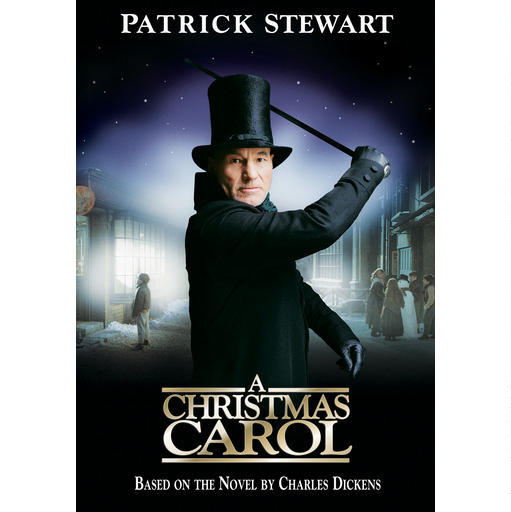1999 was a year I was on pins and needles eagerly anticipating the premiere of a new A Christmas Carol movie. This, of course, is the already classic version starring Patrick Stewart as Ebenezer Scrooge.
A Christmas Carol fanatics were well aware of his acclaimed early ‘90’s one-man theatre piece where he performs all the roles. Stewart is a real actor of the theatre, with talent that adapts well to other mediums, which is one of the reasons I admire him so much. I’ve always regretted never being able to see his one-man production. However, there is always the audio recording he did.
That being said, it was inevitable that a new film version with Stewart would be made. However, unlike his stage tour de force, this meant he was confined to a single role, which of course is the lead. And he delivers!
It’s impressive this is actually a made-for-television conception. But I learned from the 1984 adaptation that television could do a respectful and quality version.
 Stewart’s interpretation of Scrooge is not the stereotypical crotchety old man or the bent over, crooked man out of a Victor Herbert operetta. His Scrooge is a powerful man to be reckoned with, often seeming eagerly ready to confront the fools he perceives around him. I think both the writing and acting of this Scrooge present an interpretation of him that is more aware of his past self and transgressions and more consciously chooses to put them in the back of his mind.
Stewart’s interpretation of Scrooge is not the stereotypical crotchety old man or the bent over, crooked man out of a Victor Herbert operetta. His Scrooge is a powerful man to be reckoned with, often seeming eagerly ready to confront the fools he perceives around him. I think both the writing and acting of this Scrooge present an interpretation of him that is more aware of his past self and transgressions and more consciously chooses to put them in the back of his mind.
During the visit to the past, as the Ghost is about to show Scrooge the breakup between Belle and his younger self, Scrooge sees the figures in the distance. It’s then made apparent Scrooge knows what is about to transpire as he turns away and says: “The years change people, I don’t wish to look, sir.” In most versions, this scene is played as if Scrooge is being reminded of memories his hard heart has purged. It seems more realistic here as Scrooge is being forced to look at what he still remembers but won’t contemplate.
Getting back to the movie, itself…
This is one of the nearest to complete versions of the story that’s been done. As with any version, there are some liberties taken with some scenes and dialogue. Still, the liberties are slight and thus never distract within the completeness of the film. But as much of a plus being “near complete” is, you need good people to make it work. This is a great cast, all wonderful in their parts! Much of the cast may not be household names but are well experienced; a great many faces are recognizable (more so if you view a lot of English made productions). One other item: the special effects are top-notch without ever being overbearing, sidetracking, or upstaging.
 I particularly like the three Christmas spirits. Joel Grey is the Ghost of Christmas Past. This is the most difficult of the Ghosts to visually portray when going by Dickens’ description. This is one of the best visual portrayals using a live actor. The realization of this portrayal is better credited to the make up and effects. Dickens described the spirit:
I particularly like the three Christmas spirits. Joel Grey is the Ghost of Christmas Past. This is the most difficult of the Ghosts to visually portray when going by Dickens’ description. This is one of the best visual portrayals using a live actor. The realization of this portrayal is better credited to the make up and effects. Dickens described the spirit:
It was a strange figure—like a child: yet not so like a child as like an old man, viewed through some supernatural medium, which gave him the appearance of having receded from the view, and being diminished to a child’s proportions. Its hair, which hung about its neck and down its back, was white as if with age; and yet the face had not a wrinkle in it, and the tenderest bloom was on the skin.
The rest of the description that follows defines a surreal, continuously metamorphosing entity (this part was best realized in the incredible 1971 animated Chuck Jones version). Thanks to excellent special effects, this is the only non-animated version where you’ll see Scrooge fully dispense with the Ghost using the extinguisher-cap, not simply insinuating it.
Both Ghosts of Present and Yet-to-Come couldn’t be more traditional. This film joined the ranks of the rarest in live-action versions: the Present Ghost takes Scrooge to see the minors, the lighthouse, and the ship at sea to demonstrate how they know the Spirit of Christmas. However, this is where one of the liberties I mentioned comes in. It adds a fourth scene by taking Scrooge to a jail to witness inmates singing a carol.
The one part that seems a bit unusual is the normal human looking hand and outstretched arm of the Ghost of Yet-to-Come.
There is only one thing in this offering I really don’t like: Scrooge’s sister is named Fran instead of Fan. To some this may seem really trivial but we all have our peeves. (Dickens had a sister named Fanny and I’ve always been convinced that Scrooges’ beloved sister’s name was no coincidence.)
Since the time this was made, I’ve known many varying opinions by others. Some rate this as the #1, more so #2, of favorite or best adaptations. Some others believe that it is mediocre, usually still singling out Stewart for his performance. As I stated in the first post, everything here is my own opinion. My opinion is: this is by far one of the top versions of A Christmas Carol. It is not my favorite and I do not think it the best to date, but it is hands down top 5! Must see viewing.
Effects I Really Liked
- Marley’s face on fireplace tiles in Scrooge’s room
- The scene transition from Scrooge’s room to his boyhood school location
- Extinguishing the Ghost of Christmas Past
- The wind The Ghost of the Past and Scrooge rode to view various Christmas scenes
What is Not Missing
- Marley’s funeral
- Ignorance & Want
- Tiny Tim’s corpse
- Scrooge’s shrouded corpse (missing in more versions than you’d expect)
Missing
As complete as this version is, it still has some missing bits, the two most noticeable being:
- Phantom hearse
- Belle as a married woman (“comely matron”)

Pingback: A Christmas Carol, 1938 | 25 Days of A Christmas Carol